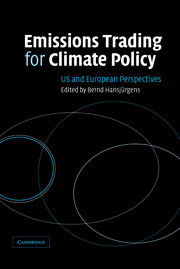Book contents
- Frontmatter
- Contents
- List of figures
- List of tables
- List of contributors
- Preface
- List of abbreviations
- 1 Introduction
- Part 1 Regulatory instruments for climate policy: theoretical aspects
- Part 2 The US approach to pollution control: lessons for climate policy
- Part 3 European policies to control greenhouse gases: the EU directive on emissions trading
- 9 Regulation or coordination: European climate policy between Scylla and Charybdis
- 10 Lobbying and CO2 trade in the EU
- 11 Greenhouse gas emissions trading in the EU: building the world's largest cap-and-trade scheme
- 12 Legal aspects of the European Emissions Trading Scheme
- 13 Emissions trading schemes in Europe: linking the EU Emissions Trading Scheme with national programs
- 14 Concluding observations
- Index
- References
13 - Emissions trading schemes in Europe: linking the EU Emissions Trading Scheme with national programs
Published online by Cambridge University Press: 22 September 2009
- Frontmatter
- Contents
- List of figures
- List of tables
- List of contributors
- Preface
- List of abbreviations
- 1 Introduction
- Part 1 Regulatory instruments for climate policy: theoretical aspects
- Part 2 The US approach to pollution control: lessons for climate policy
- Part 3 European policies to control greenhouse gases: the EU directive on emissions trading
- 9 Regulation or coordination: European climate policy between Scylla and Charybdis
- 10 Lobbying and CO2 trade in the EU
- 11 Greenhouse gas emissions trading in the EU: building the world's largest cap-and-trade scheme
- 12 Legal aspects of the European Emissions Trading Scheme
- 13 Emissions trading schemes in Europe: linking the EU Emissions Trading Scheme with national programs
- 14 Concluding observations
- Index
- References
Summary
Introduction
Emissions trading was first introduced in the United States during the mid-1970s. It was applied in several ways (e.g. to lead-free petrol and to ozone-depleting chemicals) among which the Acid Rain Program may have the closest similarity with potential national CO2 trading schemes (UN 1995, pp. 19–23). In the context of the UN Framework Convention on Climate Change it first looked as if taxes could be the instruments of choice for countries to control the greenhouse gas emissions (NRP, 1995, p. 1). However, emissions trading at state level was finally formally introduced with the Kyoto Protocol, agreed in 1997. As parties to the Protocol lack information on abatement options and costs, the theoretical efficiency gains may never be realized by nation-to-nation trading. This may be one reason why the discussion on national trading schemes, i.e. involving sub-national entities, has intensified remarkably since then, and numerous reports by “industry/governmental” working groups have been published throughout the industrialized world. With national schemes emerging, the question of linkage arises. We analyze this aspect in general.
On the other hand, there are, already, two existing schemes in Europe. We describe these two systems and see how they can be linked with regard to technical feasibility, environmental integrity, and economic impacts. The latter aspect will be investigated with a focus on the linking national schemes in the context only of the Kyoto provisions, as it is generally understood that the linking of different schemes itself increases overall cost-efficiency.
- Type
- Chapter
- Information
- Emissions Trading for Climate PolicyUS and European Perspectives, pp. 199 - 221Publisher: Cambridge University PressPrint publication year: 2005
References
- 2
- Cited by



